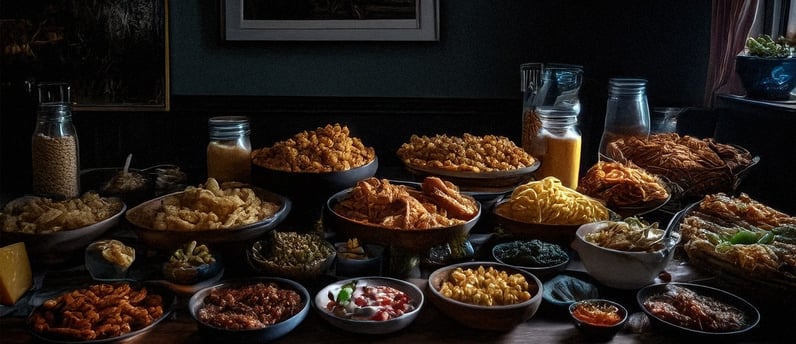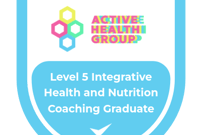Breaking Free from Ultra-Processed Foods: A Guide to Taking Back Control
This blog explores what ultra-processed foods are, how they impact our bodies and minds and the steps we can take to reduce our reliance on them. From understanding their hidden effects on our health and practical strategies for making healthier choices, this guide gives hints and tips on how to break free from the cycle of UPF consumption and regain control over your wellbeing
Lisa Painter
2/27/2025


Breaking Free from Ultra-Processed Foods:
A Guide to Taking Back Control
If you’ve been trying to lose weight, struggling with cravings, or just feeling stuck when it comes to eating better—please know, you are not alone. The truth is, the modern food industry has set us up to fail. Ultra-processed foods (UPFs) are everywhere, and they’re designed to keep us hooked. But the good news? Once you understand what’s really going on, you can start making changes—ones that will leave you feeling more energised, healthier, and in control.
I’m going to break down exactly what UPFs are, how they impact your body, and—most importantly—how you can start breaking free from them in a way that’s realistic and sustainable. And if you’re ready for real, lasting change, I have something at the end that can support you on your journey.
What Are Ultra-Processed Foods?
Ultra-processed foods aren’t just ‘junk food.’ They’re highly engineered products made with artificial additives, refined sugars, unhealthy fats, and preservatives. They’re designed for one thing—to make food companies money—by being cheap to produce, addictive, and having a long shelf life.
In creating UPFs, industrial processes are used to fractioning of wholefoods into substances, oils, fats, protein, starches and fibre – usually from high yield food (corn, wheat, soya, cane etc) and pureeing or grinding of animal carcass usually from intensive live-stock farming.
What makes them different from regular processed foods?
They contain at least ONE ingredient you wouldn’t find in your kitchen (like hydrogenated oils, high-fructose corn syrup, and artificial flavour enhancers).
They’re designed to override your hunger signals and make you eat more than you need.
They lack real nutrients, fibre, and protein, leaving you unsatisfied and craving more.
They provide low satiety
Examples of UPFs: (these are just a few – by no means all of them)
Soft drinks, energy drinks, flavoured coffees
Sweet or savoury packaged snacks
Instant noodles, frozen ready meals, and fast food
Processed meats, poultry nuggets, and fish fingers
Sweets and biscuits
Mass-produced packaged bread
Did you know that UPFs make up over half of the total diet consumed in high income countries like USA, Canada and UK? At times this is 80% or more of a diet consumption!
How Ultra-Processed Foods Affect Your Body & Mind
Ever wonder why one biscuit turns into five? Or why you feel hungry again after eating a fast-food meal? That’s not a lack of willpower—it’s food science at work.
Here’s what UPFs do to your body:
Trigger cravings – They stimulate the “bliss point” in your brain, releasing dopamine, just like addictive substances.
Spike blood sugar – Leading to energy crashes, cravings, and fat storage.
Slow your metabolism – Causing inflammation, bloating, and sluggishness.
Rewire your brain – Studies show they create new neural pathways that make you want more and more over time.
Create a gut environment that select microbes that promote inflammatory disease
An increase in the consumption of UPFs deteriorates the nutritional quality of the diet which increases obesity, high blood pressure, coronary & cardiovascular disease, gastro-intestinal disorders and cancer
The more UPFs you eat, the harder it becomes to stop. But the good news? You can retrain your body and brain to crave real food again.
How to Spot Ultra-Processed Foods (Before They Trick You!)
UPFs are sneaky. They often come in fancy packaging with words like ‘healthy,’ ‘high in protein,’ or ‘low fat.’ But here’s how to know if a food is ultra-processed:
Check the ingredients: If it contains just one thing you wouldn’t cook with—like emulsifiers, stabilisers, artificial sweeteners, or hydrogenated oils—it’s likely a UPF.
Long shelf life? Foods designed to last are usually full of preservatives.
Super convenient & addictive? If it’s something you can eat straight from the package and can’t stop at just one, it’s probably ultra-processed.
Breaking Free: How to Reduce Ultra-Processed Foods (Without Feeling Deprived!)
Here’s the truth—this isn’t about never eating processed foods again. It’s about reducing them so you can feel better, regain control over your eating habits, and nourish your body properly.
A great way to start a foundation is to create a pro’s and con’s list.
For example, a Pro’s list could be to have more energy, lose fat, live longer, feel healthier, reduce symptoms of a chronic illness, feel better each day, better sleep.
Your Con’s list could contain – I can’t eat ice-cream with the kids, saying no to a bisuit with a cuppa, saying no to others and possibly having to explain my food choices to others
Literally write everything down, however vain it may sound. Once done, compare the two lists and decide if limiting or giving up UPFs is worth it.
Step 1: Awareness is Key
Don’t blame yourself. These foods are designed to keep you hooked.
Start paying attention to how they make you feel—do you crash after eating them? Feel constantly hungry?
Step 2: Make Small, Realistic Swaps
Instead of sugary cereal → Try porridge with fresh fruit 🍓
Instead of flavoured yogurt → Go for plain yogurt + honey or fruit 🍯
Instead of a packaged snack → Grab a handful of nuts 🥜
You don’t have to go cold turkey overnight. Just one swap at a time makes a difference.
Step 3: Plan Ahead & Make Healthy Foods Convenient
Prep meals in advance so you don’t rely on convenience foods.
Stock your kitchen with real, whole foods—fruits, veggies, lean proteins, and whole grains.
Limit snacking—most ultra-processed snacks are designed to be eaten mindlessly.
Step 4: Detox Your Taste Buds
Give your brain time to reset. Even a few weeks without UPFs can reduce cravings.
Find healthier comfort foods. Love ice cream? Try blended frozen bananas! 🍌
Need Help? Let’s Do This Together!
I know breaking free from UPFs isn’t easy, and sometimes, it’s overwhelming to do it alone. That’s exactly why I created my 16 week Health & Nutrition Coaching Program—Flourish - to guide you step by step, without crash dieting or feeling deprived.
This 16 week program, includes:-
8 x 1 hour one-to-one zoom coaching session
Inner critic and limiting belief work – stop that voice from saying you can’t do this
Support & accountability so you don’t have to do this alone
Tailor made programme to support your specific needs
If you’re tired of feeling stuck and ready to feel better, lighter, and in control, I’d love to help you. Click Here to learn more and take the first step toward real, lasting change.
Remember—this isn’t about being perfect. It’s about making better choices, one step at a time. You deserve to feel good in your body, and you absolutely have the power to take back control over your food choices. And if you need support? I’m here for you.




